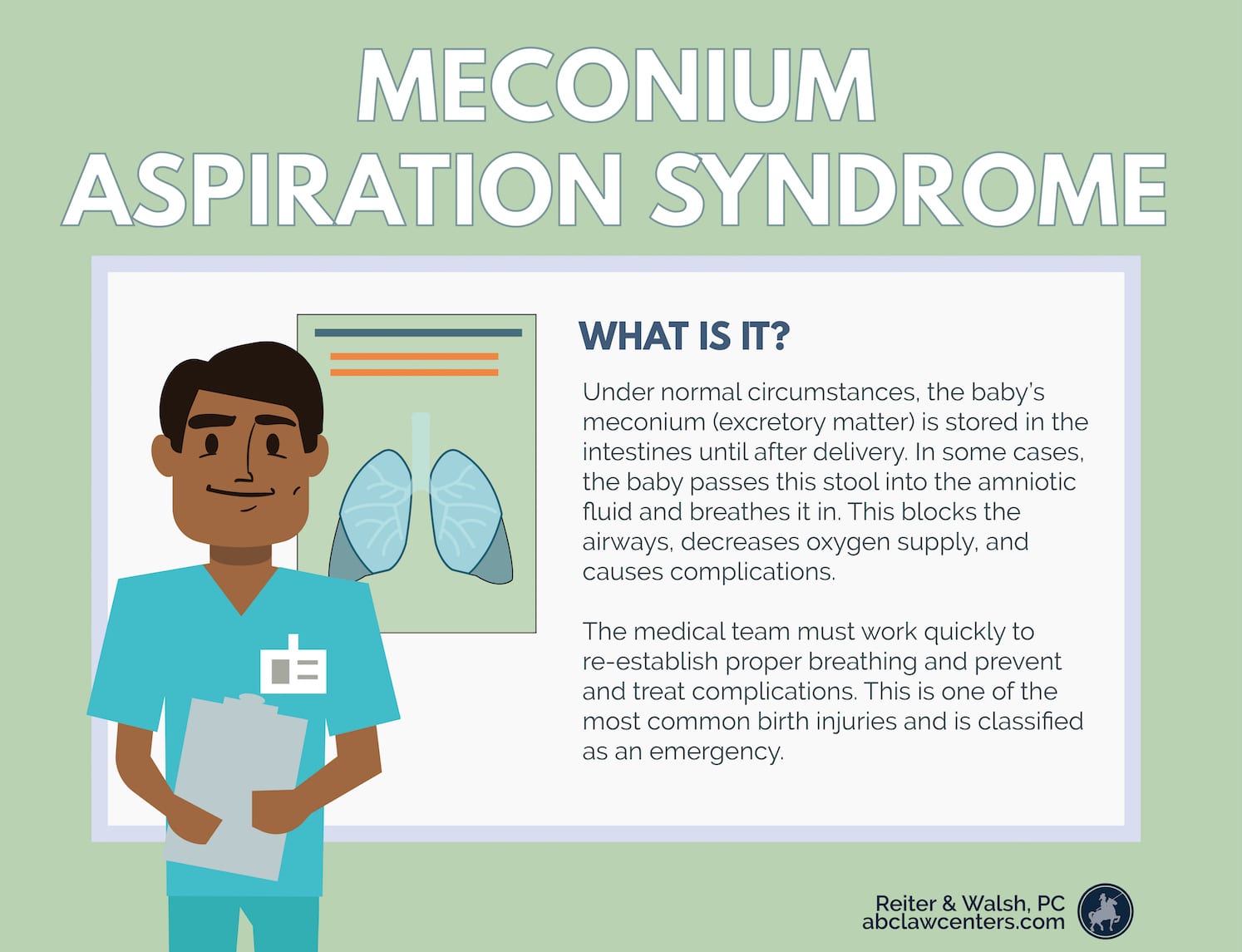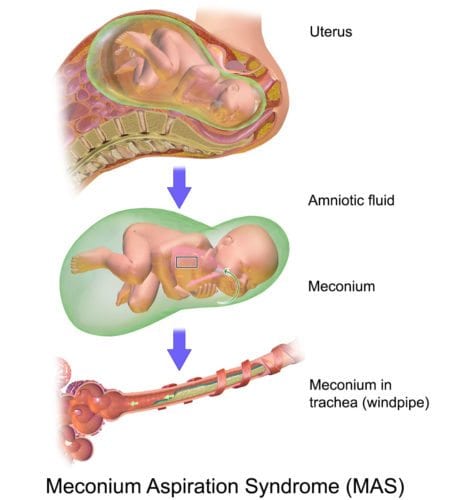Meconium Aspiration (MAS) and Birth Injury
Under normal circumstances, a baby’s meconium (excretory matter) is stored in the intestines until after delivery. However, if a baby is in distress before or during the birthing process, they may pass meconium while still in utero. If this happens, the meconium can mix into the amniotic fluid, and the baby may breathe (aspirate) it into their lungs just before, during, or after birth. This is known as meconium aspiration syndrome (MAS). Although MAS is often treatable, the meconium can lead to serious complications such as inflammation/infection of the lung (pneumonia), blocked airways, lung rupture/collapse (pneumothorax), persistent pulmonary hypertension of the newborn (PPHN), and brain damage due to a lack of oxygen (hypoxic-ischemic encephalopathy) (1). This is one of the most common birth injuries and is classified as an emergency.

Risk factors and causes of meconium aspiration syndrome (MAS)
If a baby is in distress around the time of labor, this can cause the baby’s intestines to contract and the anal sphincter to relax, which allows meconium to pass into the amniotic fluid and contaminate it. Risk factors and causes of meconium aspiration include the following (1, 2, 3, 4):
- Postmaturity (i.e. the due date has passed, and the baby has not yet been born). This is a risk factor for several reasons:
- Fetuses usually do not produce meconium until they are almost at term, which means that when a baby goes post-term, there is a longer period of time during which they could potentially pass and inhale meconium.
- After term, there is also typically less amniotic fluid in the amniotic membranes, which means that if a baby passes meconium, it is less diluted.
- Post-term pregnancies often involve placental insufficiency, which means that there is decreased oxygen traveling to the baby. This can cause fetal distress.
- Birth asphyxia/hypoxia (oxygen deprivation around the time of birth)
- Chronic intrauterine hypoxia (prolonged oxygen deprivation)
- Intrauterine growth restriction (IUGR)/small for gestational age
- Difficult delivery or prolonged labor
- Maternal hypertension, including preeclampsia
- Maternal diabetes, including gestational diabetes
- Oligohydramnios (low amniotic fluid)
- Chorioamnionitis

Signs and symptoms of meconium aspiration syndrome
The following signs may indicate that an unborn baby has swallowed meconium:
These signs of meconium aspiration syndrome may be present after a baby is born (1, 4, 5):
- Respiratory distress (e.g. fast breathing or grunting while breathing)
- Apnea/failure to breathe (if airways are blocked by meconium)
- Cyanosis (bluish tint to the skin and other bodily surfaces)
- Low blood pressure
- Limpness
- Barrel-shaped chest (because of trapped air)
- A greenish staining of the amniotic fluid, which may appear on the baby’s skin, fingernails, or umbilical cord
- The baby’s urine is green
- Low Apgar score (An Apgar score is an assessment of the newborn the first few minutes of life that considers factors such as the baby’s skin color/complexion, pulse rate, reflexes, muscle tone, and breathing.)
- Metabolic acidosis. Blood tests may show a low pH, or acidic blood (see “Diagnosing Meconium Aspiration Syndrome”).
These signs of meconium aspiration syndrome may be present while the baby is still in utero (5):
- Meconium seen in the amniotic fluid when the mother’s water breaks (amniotic membranes rupture)
- Signs of fetal distress such as an abnormal heart rate on the fetal monitor
Diagnosing meconium aspiration syndrome
Inhalation of meconium can be confirmed by one or more of the following tests (3):
- The healthcare team listens to the baby’s chest with a stethoscope and hears abnormal breath sounds, especially coarse, crackly sounds.
- An analysis of the baby’s blood shows acidic blood (low pH), decreased oxygen, and increased carbon dioxide.
- A chest x-ray may show patchy or streaky areas in the baby’s lungs, among other possible abnormal findings.
Treating meconium aspiration syndrome
If a baby is at risk for MAS, fetal monitoring should be done in order to prevent dangerous complications. If the baby is not receiving enough oxygen-rich blood, or if the baby’s heart rate is low, doctors must act quickly to restore blood flow and oxygen supply. If oxygen and blood supply cannot be restored, an emergency delivery such as a C-section should be performed. It is essential that a team skilled at reviving newborn babies be present at the delivery if meconium staining is found in the amniotic fluid. Failure to adequately monitor the baby or a delay in emergency delivery can cause significant brain damage, injury, or even death of the baby.
Treatment of MAS may include the following (1, 3):
- Suctioning of the nose, mouth, and throat
- Using a face mask and bag to help inflate the baby’s lungs and delivery oxygen
- Insertion of a breathing tube
- Oxygen therapy
- Use of a radiant warmer (this can help maintain the baby’s body temperature)
- Administration of antibiotics such as ampicillin and gentamicin
- Use of a ventilator to assist with breathing
- Extracorporeal membrane oxygenation (ECMO) if other treatments aren’t working or the baby has high blood pressure within the lungs
- Feeding through an IV (if breathing problems prevent the baby from being fed orally)
- Surfactant therapy to help with lung function
- Nitric oxide (NO) gas, which can improve blood flow and the exchange of oxygen in the lungs
The exact treatments used may vary depending on the severity of MAS and other unique circumstances. Babies who are active and crying may require no treatment. Others may require only mild interventions, such as being dried, warmed, and stimulated. Interventions such as surfactant therapy, nitric oxide, and ECMO are reserved for more severe cases.
Complications associated with meconium aspiration syndrome
Most babies with MAS recover well and have a good long-term prognosis. However, there are significant complications that can occur in babies with MAS, especially when they do not receive proper treatment.
When MAS occurs, it is essential that the medical team act quickly to try and restore normal breathing and prevent or minimize meconium aspiration complications. Often, emergency resuscitation efforts are required to restore the baby’s breathing and, sometimes, the baby’s heartbeat. It is very important that the medical staff know how to spot the potential for meconium aspiration and be equipped and prepared to handle this type of emergency. Failure to properly manage meconium aspiration can cause the baby to experience respiratory distress, hypoxic-ischemic encephalopathy (HIE), seizures, cerebral palsy, and other serious complications.


Our experience handling meconium aspiration and birth injury cases
When your baby suffers a preventable birth injury, it can feel impossible to understand and process the medical and legal aspects of the situation. Parents are often left wondering how they will find the support, information, and resources necessary to provide for their child. From our main office near Detroit, Michigan, the ABC Law Centers: Birth Injury Lawyers team helps families all over the United States.
If your child was diagnosed with a birth injury from meconium aspiration syndrome or another complication, illness, or medical error, we encourage you to reach out for a free case review.
Featured Videos
Posterior Position
Hypoxic-Ischemic Encephalopathy (HIE)

Featured Testimonial
What Our
Clients Say…
After the traumatic birth of my son, I was left confused, afraid, and seeking answers. We needed someone we could trust and depend on. ABC Law Centers: Birth Injury Lawyers was just that.
- Michael
Helpful resources
- Meconium Aspiration Syndrome: Causes, Symptoms, and Diagnosis. (n.d.). Retrieved January 2, 2019, from https://www.healthline.com/health/meconium-aspiration-syndrome#complications
- (n.d.). Retrieved January 2, 2019, from https://www.uptodate.com/contents/clinical-features-and-diagnosis-of-meconium-aspiration-syndrome
- Meconium aspiration syndrome: MedlinePlus Medical Encyclopedia. (n.d.). Retrieved January 2, 2019, from https://medlineplus.gov/ency/article/001596.htm
- Meconium Aspiration Syndrome. (2017, July 20). Retrieved January 2, 2019, from https://emedicine.medscape.com/article/974110-overview
- Greenspan, J. S. (Ed.). (2014, October). Meconium Aspiration (for Parents). Retrieved January 2, 2019, from https://kidshealth.org/en/parents/meconium.html


